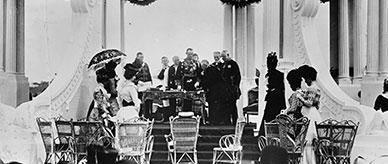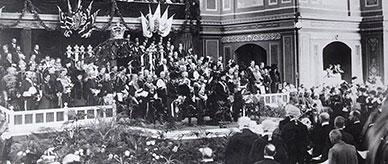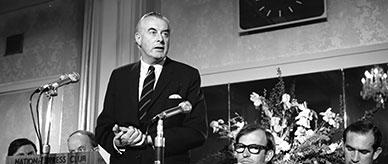


About this record
This is a sepia-toned photograph showing a wide view of the ceremonial founding of the new federal capital city, Canberra. It shows mounted horsemen in a square formation on a grassy open plain surrounded by eucalyptus trees. The photograph is wide, measuring 63.5 centimetres by 38 centimetres, and appears to be a composite of several individual shots. It has a beige border with the words 'Laying Foundation Stone – Federal City – Canberra – 12 March 1913' centred on the bottom of the border.
Educational value
- This photograph shows a key moment in Australia's history – the official foundation of the new federal capital. The significance of this event is evident in the elaborately organised ceremony and the presence of ceremonial troops and important political figures, including Prime Minister Andrew Fisher and Governor-General Lord Denman. Construction of Canberra had begun two weeks earlier on 20 February 1913 with a small ceremony for placing the first survey pegs.
- The official foundation ceremony included the unfurling of the Union Jack and the firing of a 19-gun royal salute on the arrival of the Governor-General in full dress uniform, with a 21-gun royal salute after Lady Denman had named the new city. The vice-regal and military ceremonial elements indicate the importance given to traditions inherited from the British Empire.
- The horsemen shown in the photograph, reportedly numbering some 2000 troops, are Light Horsemen, Lancers and Mounted Riflemen from New South Wales who formed an escort at the ceremony. Military cadets from Duntroon Military College, established in 1911, provided the official guard of honour. The prominence given to the troops and military cadets in the ceremony, in press accounts and the official records of it, indicates the intensive defence build-up at the time, which included compulsory military training for schoolboys.
- Although this ceremony took place in 1913 it was not until the 1920s that construction of the city proceeded. The most important public building, Parliament House, was completed in 1927. The outbreak of World War I in 1914 diverted resources and time away from the building of Canberra. Construction plans were also stalled with the onset of the Great Depression in 1929 and then in 1939 with the outbreak of World War II.
- Over 4000 spectators watched the proceedings, including around 500 invited guests who arrived on special trains from Melbourne and Sydney to be part of the day's events. The invited guests were seated on specially made stands. While the population of Canberra in 1911 was only 1714, it swelled to more than 5000 people on the day. Since there were few existing buildings, guests stayed in nearby Queanbeyan or returned home by train that evening
Acknowledgments
Learning resource text © Education Services Australia Limited and the National Archives of Australia 2010.
Related themes
Need help with your research?
Learn how to interpret primary sources, use our collection and more.



